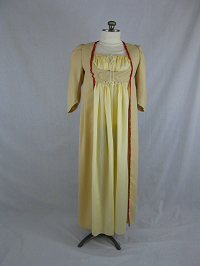1795-1800
The French Revolution brought about a dramatic change in clothing. The interest in classical Greece meant a new freedom for the body which had long been confined in metal, bone, and cloth. At first ladies wore only chemises, but they found it took a perfect figure to display them properly, so they soon added tunics and open gowns, like this yellow silk chemise beneath a pale wool open gown. The frontpiece, called a vest, is closed with straight pins. It was still not fashionable for women to wear buttons. The shoulder seam set far to the back, runs down into the armhole, where it is met by the back seams. The skirt and bodice are cut in one piece with the back seams falling into box pleats to allow the needed fullness at the hipline. A small pad keeps the gown in a straight line, shoulders to hips. Red cording accents the seams and front opening.
The practice of cutting the hair of the nobles before sending them to the guillotine inspired short hair styles that were covered by a fanciful turban. Gloves covered the exposed arms and hands. Short gloves were worn with long sleeves and long with short sleeves. A reticule was carried for necessities, such as a nose cloth, or perhaps a few pennies for the beggars. Shoes were of soft leather and had no heel; sometimes, like a sandle, they included ties up the leg.
Click photo for detailed views.


